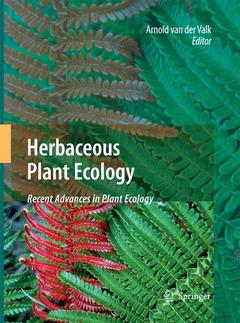Plant species richness and diversity of the serpentine areas on the Witwatersrand.- Temporal changes in species diversity and composition in abandoned fields in a trans-Himalayan landscape, Nepal.- Role of desert annuals in nutrient flow in arid area of Northwestern China: a nutrient reservoir and provider.- The effects of fire frequency and grazing on tallgrass prairie productivity and plant composition are mediated through bud bank demography.- Do plant functional types based on leaf dry matter content allow characterizing native grass species and grasslands for herbage growth pattern?.- Clonal growth strategies in simultaneously persistent and expanding Trifolium repens patches.- California native and exotic perennial grasses differ in their response to soil nitrogen, exotic annual grass density, and order of emergence.- Do seed and microsite limitation interact with seed size in determining invasion patterns in flooding Pampa grasslands?.- Feral horses dung piles as potential invasion windows for alien plant species in natural grasslands.- Reproductive allocation of Carex flava reacts differently to competition and resources in a designed plant mixture of five species.- Factors affecting the establishment and growth of annual legumes in semi-arid mediterranean grasslands.- Are irrigation and grazing effects transferred, accumulated, or counteracted during plant recruitment?.- Extent and spatial patterns of grass bald land cover change (1948–2000), Oregon Coast Range, USA.- Grass (Poaceae) richness patterns across China’s nature reserves.- Interacting effects of grass height and herbivores on the establishment of an encroaching savanna shrub.- Effects of competition on root–shoot allocation in Plantago lanceolata L.: adaptive plasticity or ontogenetic drift?.-Rock-colonizing plants: abundance of the endemic cactus Mammillaria fraileana related to rock type in the southern Sonoran Desert.- Ecophysiological responses of nine floodplain meadow species to changing hydrological conditions.- Tolerance of a perennial herb, Pimpinella saxifraga, to simulated flower herbivory and grazing: immediate repair of injury or postponed reproduction?.- Differential herbivory tolerance of dominant and subordinate plant species along gradients of nutrient availability and competition.- Responses of clonal architecture to experimental defoliation: a comparative study between ten grassland species.- Diffuse knapweed (Centaurea diffusa Lam.) seedling emergence and establishment in a Colorado grassland.- Biodiversity and tallgrass prairie decomposition: the relative importance of species identity, evenness, richness, and micro-topography.- Herbivory and local genetic differentiation in natural populations of Arabidopsis thaliana (Brassicaceae).- The effect of nutrient supply and light intensity on tannins and mycorrhizal colonisation in Dutch heathland ecosystems.- Spatial and temporal dynamics of floating and drift-line seeds at a tidal freshwater marsh on the Potomac River, USA.- Estimating plant competition coefficients and predicting community dynamics from non-destructive pin-point data: a case study with Calluna vulgaris and Deschampsia flexuosa.- Disturbance by mowing affects clonal diversity: the genetic structure of Ranunculus ficaria (Ranunculuaceae) in meadows and forests.- Soil amendment effects on the exotic annual grass Bromus tectorum L. and facilitation of its growth by the native perennial grass Hilaria jamesii (Torr.) Benth.- Effects of fire on the vegetation of a lowland heathland in North-western Italy.




